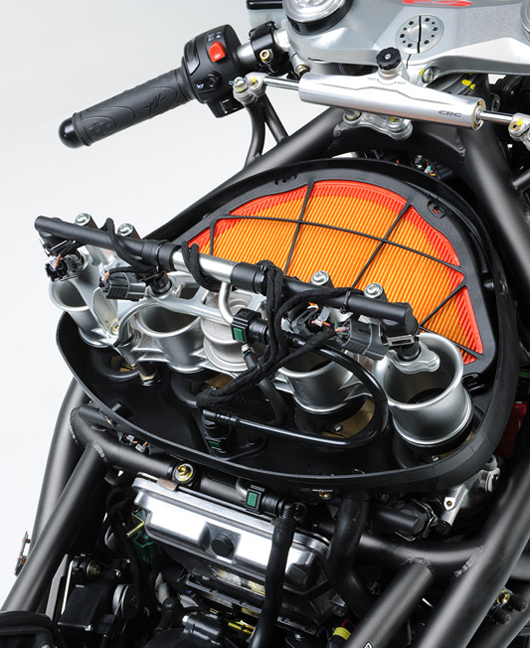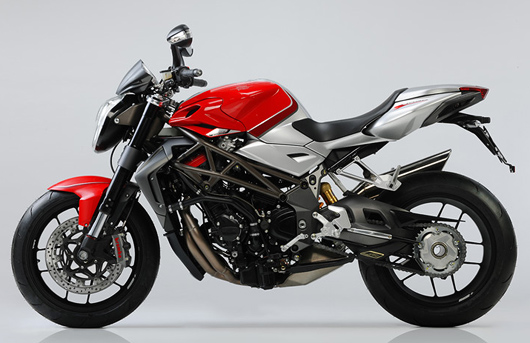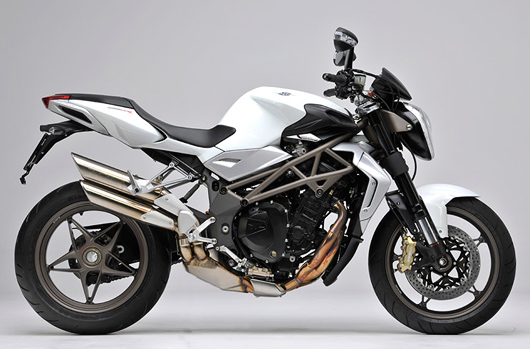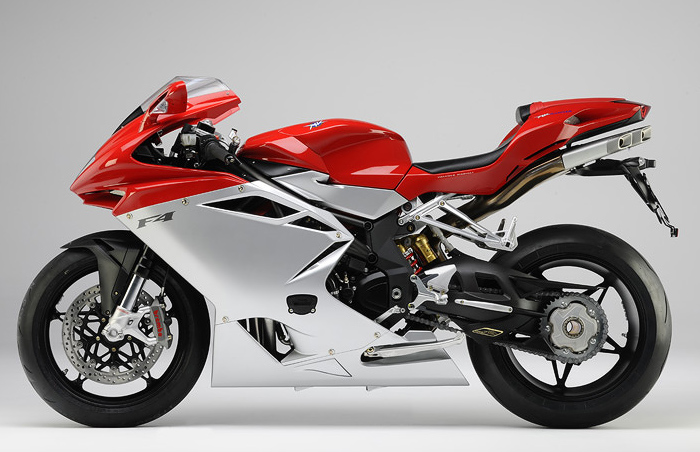.MV Agusta's 's Exciting New 2010 F4 1000cc Superbike,
Brutale 990cc and 1190cc Naked Sportbikes
November 2009 - The new MV Agusta F4, a motorcycle that from the day of its introduction has been judged as the most beautiful motorcycle in the world. The F4 defines beauty. The new F4 is not an evolution of the previous motorcycle, but it is a new project that has been studied down to the last nut and bolt, from the first to the last curve of the bodywork. No mass produced street motorcycle can boast as many accolades as the MV Agusta F4, which is the absolute reference for performance, speed and raw beauty.
The F4 is the synthesis of Italian craftsmanship, no compromise design principles and the application of the most technologically advanced materials in a single motorcycle. The F4 is a pure two-wheeled work of art. Every single component has been studied down to the finest detail and has been redesigned and/or relocated with the aim of gaining an ultra-solid, light weight and perfectly balanced motorcycle.
The ergonomics are completely new, meticulously calculated with a single objective in mind: to help the rider utilize the increased performance when riding at the limit. With its advanced technology and extraordinary performance, the F4 defines the new standard for supersport motorcycles.
The new F4 is available in three different colour combinations:
- Pastel red/metallic silver
- Gloss black/matt black
- Titanium grey/admiral grey

Design - When form becomes beauty. The design of the F4 is a revolution of form and function. It is now lower, sleeker and even more aggressive than the original, but with the unmistakable look of an MV Agusta. No in line 4-cylinder motorcycle in the world can boast such a reduced frontal area which is comparable with the frontal area of a twin-cylinder motorcycle. The extended surfaces of the fairings (which have always characterised the F4) have tapered air outlets that improve the evacuation of warm air, the aerodynamic efficiency and still let you get a glimpse of the red vale cover of the radial-valve 4-cylinder engine.
Even the mirrors contribute to the aerodynamic efficiency with a new shape and two small aerodynamic appendices that eliminate turbulence and help to protect the rider's shoulders. The tail section is even more sleek, the windscreen is more penetrating and sharper, the size of the seat has been reduced, the tank is shorter, the handlebars are wider and have been raised for an incredible drive control and comfort. The front optical group is similar in shape to the unforgettable one of the first F4, but it is even more compact and effective, an innovative first in sports motorcycles.
In fact, for the first time on a motorcycle a poli-elliptical monoelement light with xenon bulb serves a double function of main headlight and running lights taking advantage of the compactness and the reduced weight of the optical group itself. The parking light uses Led technology, as well as the rear tail light and the indicators. The advantages of this technology are by now well known: higher visibility, less weight.

Engine - The new 4-cylinder engine, with it's 16 radial valves, retains only the values of bore and stroke with its predecessor: 76x55 mm. But, it takes advantage of all the experience developed in prior racing activities together the most advanced technology in order to maintain its status as the point of reference for the supersport class. It represents an evolution of the previous engine, but the advancements are so profound that it is considered a completely new engine.
The profound development that it was subject to ensures exceptional performance as well as a perfect marriage of throttle control and rear wheel traction. The crankshaft has been redesigned and the inertia has been increased by 50% compared to the previous engine. Also, the connecting rods have been completely redesigned. They are now lighter, and at the same time, stronger than the previous connecting rods.
The intake tracts have been shortened substantially to obtain the best cylinder filling efficiency and the maximum performance at all rpm's. To "fill in" the torque curve and to improve the fuel supply the new 49 mm Mikuni throttle bodies have been employed in conjunction with the TSS variable intake system. For the first time on a mass produced motorcycle, MV has integrated the new Marelli 7BM ECU to perfectly control all of the electronic systems of the F4.
This new ECU controls the 8 fuel injectors in the engine management system, the variable length intake tracts as well as the exhaust control valve, the gear selection switch and the new MK II Traction Control algorithms along with the double EFI Sport and Rain maps. Every single component of the engine has been analyzed, re-engineered and lightened. The already excellent performance of the 4-cylinder MV has been improved again from this new engine which supplies the maximum power of 137 Kw (186,3 hp) at 12900 rpm.
Exhaust system - The characteristic "organ pipe" exhaust system has always been a distinctive element of the F4 and it will be such also in the new version, which however optimizes the concept utilizing one scheme 4-in-1 tuned with the racing characteristics of the new engine.
The 4 "outlets" under the tail section have been redesigned and are removable offering the possibility of being personalised with MV aftermarket accessories.
Chassis - The chassis is one of the foundations which has made the original MV Agusta F4 unique and unmistakable. An extremely rational and light structure which is characterised by the union of a steel lattice structure coupled with aluminium side plates. The new chassis is narrower, shorter and lighter. The area of the steering stem has been completely revised and the side plates have been moved forward, this has allowed an optimal weight distribution (52% front, 48% rear).
Every component has been made compact and has been optimised to be adapted to the new layout of the motorcycle. The redesign of the rear swing arm assembly has drastically reduced the weight by 1,2 kg (2.65 lbs) while maintaining the same level of torsional rigidity. The front fork of the new F4 weighs an incredibly low 5 kg (11.02 lbs) which sets a new standard of low weight in the superbike class.
Brakes - The Brembo front system with radial monobloc callipers is without a doubt the best system on the market. On the F4 it is joined to a Nissin pump with integrated reservoir and produced to specific MV standards.
Attention to detail - Excellence in every component What characterizes and distinguishes the MV Agusta F4 from the rest of the supersport motorcycles is the relentless attention paid to every single element and detail. The dashboard of the F4 is not simply a display where data can be read, but it is the digital interface between the rider and the motorcycle.
The dashboard uses CAN line technology to reduce the wiring harness to a minimum, also contributing to the reduced overall mass of the motorcycle. With the application of this technology MV Agusta has once again introduced a new standard to which other manufacturers will have to adapt. The dashboard, completely digital, uses digital matrix technology which offers perfect integration and instant response from the digital data display. The dashboard is very light, it offers a tremendous amount of data including vehicle speed, engine rpm, gear map, Traction Control level and lap timer for use during track events.
The maniacal persuit of weight reduction has led to the redesign of the superstructure. The result is a reduction of 3 Kg (6.61 lbs) of the fairing and 300 gr (4.8 oz) from the plexiglas windscreen. The motorcycle has been improved in every single detail with a single goal in mind: to be the best.
F4 MODEL YEAR 2010 SPECIFICATIONS
ENGINE
TYPE FOUR CYLINDER, 4 STROKE, 16 VALVE
TIMING SYSTEM"D.O.H.C", RADIAL VALVE
TOTAL DISPLACEMENT998 CM3 (60.9 CU. IN.)
COMPRESSION RATIO13.1:1
STARTINGELECTRIC
BORE X STROKE76 MM X 55 MM (3.0 IN. X 2.2 IN.)
MAX. HORSE POWER-R.P.M. (AT THE CRANKSHAFT)FULL POWER VERSION: 137 KW (186 HP) AT 12900 - LIM. 13500 R.P.M. / RESTRICTED POWER VERSION: 73 KW (100 HP) AT 9200 - LIM. 10800 R.P.M.
MAX. TORQUE-R.P.M.FULL POWER VERSION: 114 NM (11.4 KGM) AT 9500 R.P.M. / RESTRICTED POWER VERSION: 90 NM (9.0 KGM) AT 5500 R.P.M.
COOLING SYSTEMCOOLING WITH SEPARATED LIQUID AND OIL RADIATORS
ENGINE MANAGEMENT SYSTEMMAGNETI MARELLI IAW 7BM IGNITION - INJECTION INTEGRATED SYSTEM WITH MIKUNI THROTTLE BODY;
INDUCTION DISCHARGE ELECTRONIC IGNITION;
SEQUENTIAL TIMED “MULTIPOINT” ELECTRONIC INJECTION;
VARIABLE HEIGHT INTAKE DUCTS WITH TORQUE SHIFT SYSTEM (TSS)
CLUTCHWET, MULTI - DISC
GEAR BOXCASSETTE GEARBOX; SIX SPEED, CONSTANT MESH
PRIMARY DRIVE50/79
GEAR RATIOFIRST GEAR: SPEED* 13/38 128,2 KM/H (79.6 MPH) A T 13500 R.P.M.
SECOND GEAR: SPEED* 16/34 176,4 KM/H (109.5 MPH) AT 13500 R.P.M.
THIRD GEAR: SPEED* 18/32 210,8 KM/H (130.9 MPH) AT 13500 R.P.M.
FOURTH GEAR: SPEED* 20/30 249,8 KM/H (155.1 MPH) AT 13500 R.P.M.
FIFTH GEAR: SPEED* 22/29 284,3 KM/H (176.5 MPH) AT 13500 R.P.M.
SIXTH GEAR: SPEED* 19/23 305,0 KM/H (189.4 MPH) AT 13500 R.P.M.
* = TOP SPEED ATTAINED ON CLOSED COURSE.
FINAL VELOCITY RATIO15X41
DIMENSIONS
WHEELBASE1430 MM (56.27 IN.)
OVERALL LENGHT2100 MM (82.63 IN.)
OVERALL WIDTH750 MM (29.51 IN.)
SADDLE HEIGHT860 MM (33.84 IN.)
MIN. GROUND CLEARANCE115 MM (4.52 IN.)
TRAIL100,4 MM (3.93 IN.)
DRY WEIGHT192 KG (423 LBS.)
FUEL TANK CAPACITY17 L (4.49 U.S. GAL.)
SUSPENSION
FRONT TYPE: UPSIDE - DOWN" TELESCOPIC HYDRAULIC FORK WITH REBOUND-COMPRESSION DAMPING AND SPRING PRELOAD EXTERNAL AND SEPARATE ADJUSTMENT
ROD DIA.50 MM (1.97 IN.)
TRAVEL ON LEG AXIS120 MM (4.72 IN.)
REAR TYPE: PROGRESSIVE, SINGLE SHOCK ABSORBER WITH REBOUND AND COMPRESSION (HIGH SPEED / LOW SPEED) DAMPING AND SPRING PRELOAD ADJUSTMENT
SINGLE SIDED SWING ARM: MATERIALEALUMINIUM ALLOY
WHEEL TRAVEL120 MM (4.72 IN.)
BRAKES
FRONT BRAKE: DOUBLE FLOATING DISC WITH Ø 320 MM (Ø 12.6 IN.) DIAMETER, WITH STEEL BRAKING BAND AND ALUMINIUM FLANGE
FRONT BRAKE CALIPERRADIAL-TYPE, SINGLE-PIECE WITH 4 PISTONS - Ø 34 MM (Ø 1.34 IN.)
REAR BRAKE: SINGLE STEEL DISC WITH Ø 210 MM (Ø 8.27 IN.) DIAMETER
REAR BRAKE CALIPERWITH 4 PISTONS - Ø 25,4 MM (Ø 1.00 IN.)
RIMS / TIRES
FRONT: MATERIAL/SIZEALUMINIUM ALLOY 3,50" X 17"
REAR: MATERIAL/SIZEALUMINIUM ALLOY 6,00" X 17"
FRONT120/70 - ZR 17 M/C (58 W)
REAR190/55 - ZR 17 M/C (75 W)
 Brutale 1090R in Red / Metalic Silver Brutale 1090R in Red / Metalic Silver
2010 BRUTALE 1090RR / 990R
Introduction – The top model in the new Brutale range is the 1090RR, an extreme motorcycle with racing components that satisfies those who seek high performance in a fascinating and elegant motorcycle. 38 Rider Word titles and 37 Constructor championships in MV Agusta's history are reflected in this project, designed without compromise and above all the new Brutale follows the new "Made in MV" philosophy which stands for total quality in a project entirely designed and developed internally.
MV Agusta takes a generational step forward with the creation of the new Brutale 990R. The new Brutale has preserved the significant style features of previous versions and is recognisable at a glance. However the Brutale is new in 85% of its components, improving its looks, its performance and its ease of use. Many of these parts have been designed and crafted by MV Agusta, rather than sourced from market suppliers, improving precision and functionality and highlighting the "Made in MV" concept.
 Brutale 990R in Pastel White Brutale 990R in Pastel White
Aesthetics - The headlight retains the same drop profile and the same dimensions, but introduces a fresh design with the introduction of a new polyellipsoidal element and a system of 8 LEDs that create a "light strip" effect, like that found on cars. The direction indicators are now incorporated into the rear mirror assembly that is larger for greater visibility.
The instrument cluster has been completely redesigned and now operates on a high speed CAN line with extra functions. There are indicators showing which gear is engaged, fuel level, speed, hazard button, water temperature, chronometer function and traction control settings.
The handlebar and footrests have a flexible fitting to improve comfort and reduce vibration levels. The new steering head has a new steering damper on the handlebar.
The radiator protectors are no longer made of metal or integrated with the mechanical components, but are now part of the bodywork. Another distinctive element that differentiates the 1090RR model are the air ducts of the air box, painted in the same colour as the tank, they become an integral part of it, and as a result, the design is even more aggressive. The valve cover is painted red to underline the extreme power of this engine.
The most evolved part of the motorcycle is the rear, thanks to a thinner, more modern tail, which makes sitting more comfortable. The LED taillight is integrated into the tail, which is no longer in plastic, but is pressure die-cast in aluminum, and is an entirely new design element. The two beautiful exhausts, which flow along the right side of the motorcycle, have been enhanced, eliminating the welding at the tips of the silencers and, above all, featuring an even more inclined and thinner cut that matches the lines of the bodywork.
The 1090RR version comes in two color formats:
- Pearl white/pastel black
- Pastel red/metallic silver
- Pastel black/graphite grey
The 990R version comes in three colours:
- Pastel red
- Pastel white
- Pastel black
990R / 1090RR Engine – The 1090RR engine displaces 1078cc for 154 hp: the new in-line four cylinder engine rises to the top of the naked motorcycle class. It derived from the base engine featured on the 990R therefore there are no variations in layout but it has been reconfigured for smoother more progressive throttle response, more solid, and harmonious than before, especially when opening-closing and when accelerating.
The same 46 mm Mikuni throttle body assembly is used, with the installation of a non-return feed that is operated by Marelli 5SM electronics that feature a new 8 step traction control.
As with the 990R, the engine crank case is 1.32 lbs lighter than the previous one, and is fitted with a counter-rotating balancing shaft to resist high-frequency secondary vibrations, which has been placed at the front of the engine and is driven directly by the primary transmission gear. The transmission ratios remain the same while the internal gearbox command mechanism is entirely new, redesigned to allow adopting a gear sensor, and to provide a smoother and more comfortable shift of the lever.
The 1090RR also features a slipper clutch, which is an original MV design. The list of new components continues along the guidelines of the 990R: there is a new Mitsubishi, Neodymium-Iron-Boron generator that weighs a full 3.52 lbs less than the previous version; the lubrication circuit has also been entirely renewed, with a double rotor pump which is smaller and lighter (by 0.75 lb), but more efficient than the previous version. The circuit is no longer divided, as it was before, and the pump serves the radiator and the engine which are placed in series. The water pump, too, has been completely redesigned, and although it is 0.13 lb lighter than the previous one, its cooling capacity is up to 65% greater at low revs.
Rolling chassis – The frame has the same design and structure as the 990R, therefore chromium molybdenum steel TIG welded trellis frame, but with a taller, lighter, and more rigid design than the previous 1078RR.
The extension of the rear swingarm (which has been entirely redesigned and is 2.2 lb lighter) lengthens the wheelbase for greater precision in the ride, increasing the torsional rigidity and decreasing the weight. The new wheelbase also reinforces the Brutale's signature stability. The 1090RR has adjustable foot rest supports that allow riders to find the ideal position for track use while the weight reduction in the wheels and swingarm provides improved suspension operation.
The rear wheel features a cush-drive, plus a new hub and bearing, the purpose of which is to make the engine more resistant to stress and to improve comfort. The 1090RR features MV Agusta-designed forged rims, with extremely thin spokes.
The front fork has a more rigid setting and is adjustable in clicks rather than number of turns as on the R. The rear shock absorber has a double compression adjustment for high and low speeds, and a separate expansion reservoir.
The front wheel trail is 4.07 in (103.5 mm), the wheelbase is 56.61 in (1438 mm), while the seat height is 32.68 in (830 mm), and the rake is 25°.
The brakes are 320 mm Brembo disks on the 1090RR, with aluminum monoblock radial racing brake calipers, with 34 mm pistons. The The 990R gets the still worthy Brembo steet brakes with slighter smaller 310mm front discs.
Riding Impressions – Despite the extreme layout, the 1090RR has a comfortable and spacious riding position. The seat allows riders of all sizes to find their ideal position and to grasp a more ergonomically placed handlebar. The sensation is that of riding a motorcycle that has grown a couple of sizes, one that is more inviting.
The sensitivity of an MV at low revs has been transformed into a strength. Riding a figure eight at a speed of little more than 1 mph, with two fingers on the handlebar, has become as easy as hurtling at 167 mph (270 km) per hour along a straight line. The notoriously fierce Brutale now demonstrates a new subtlety in its power.
When a motorcycle is easy to use, it's also easier to push to its limits. The 1090RR, with its superior technology, achieves results that no other naked can approach - particularly on the track, where it becomes a beast with an insatiable drive. At the same time, it remains obedient to the entry level rider tackling his first curves. In its sensuously rounded power, the timeless Italian spirit emerges: never before has there been such a Brutale!
1090RR ENGINE
TYPE: FOUR CYLINDER, 4 STROKE, 16 VALVE
TIMING SYSTEM"D.O.H.C", RADIAL VALVE
TOTAL DISPLACEMENT1078 CM3 (65.78 CU. IN.)
COMPRESSION RATIO13:1
STARTINGELECTRIC
BORE X STROKE79 MM X 55 MM (3.1 IN. X 2.2 IN.)
MAX. HORSE POWER-R.P.M. (AT THE CRANKSHAFT)FULL POWER VERSION: 106 KW (144.2 HP) AT 10300 / RESTRICTED POWER VERSION: 73 KW (100 HP) AT 8500 LIM. 11650 R.P.M.
MAX. TORQUE-R.P.M.FULL POWER VERSION: 112 NM (11.2 KGM) AT 8100 R.P.M. / RESTRICTED POWER VERSION: 103 NM (10.3 KGM) AT 5500 R.P.M.
COOLING SYSTEMCOOLING WITH SEPARATED LIQUID AND OIL RADIATORS
ENGINE MANAGEMENT SYSTEMMAGNETI MARELLI 5SM IGNITION - INJECTION INTEGRATED SYSTEM WITH MIKUNI THROTTLE BODY;
INDUCTION DISCHARGE ELECTRONIC IGNITION;
SEQUENTIAL TIMED "MULTIPOINT" ELECTRONIC INJECTION
CLUTCH WET, MULTI - DISC WITH MECHANICAL ANTI-SURGING DEVICE
GEAR BOXCASSETTE GEARBOX; SIX SPEED, CONSTANT MESH
PRIMARY DRIVE50/79
GEAR RATIOFIRST GEAR: SPEED* 13/38 109.7 KM/H (68.1 MPH) AT 11650 R.P.M.
SECOND GEAR: SPEED* 16/34 150.8 KM/H (93.6 MPH) AT 11650 R.P.M.
THIRD GEAR: SPEED* 18/32 180.3 KM/H (111.9 MPH) AT 11650 R.P.M.
FOURTH GEAR: SPEED* 20/30 213.7 KM/H (132.7 MPH) AT 11650 R.P.M.
FIFTH GEAR: SPEED* 22/29 243.2 KM/H (151.0 MPH) AT 11650 R.P.M.
SIXTH GEAR: SPEED* 19/23 265.0 KM/H (164.5 MPH) AT 11650 R.P.M.
* = TOP SPEED ATTAINED ON CLOSED COURSE.
FINAL VELOCITY RATIO15X41
990R ENGINE
TYPEFOUR CYLINDER, 4 STROKE, 16 VALVE
TIMING SYSTEM"D.O.H.C", RADIAL VALVE
TOTAL DISPLACEMENT998 CM3 (60.9 CU. IN.)
COMPRESSION RATIO13:1
STARTINGELECTRIC
BORE X STROKE76,0 MM X 55,0 MM (2.99 IN. X 2.17 IN. )
MAX. HORSE POWER-R.P.M. (AT THE CRANKSHAFT)FULL POWER VERSION: 102 KW (139 HP) AT 10600 / RESTRICTED POWER VERSION: 73 KW (100 HP) AT 10000 - LIM. 11650 R.P.M.
MAX. TORQUE-R.P.M.FULL POWER VERSION: 106 NM (10.6 KGM) AT 8000 R.P.M. / RESTRICTED POWER VERSION: 97 NM (9.7 KGM) AT 5500 R.P.M.
COOLING SYSTEMCOOLING WITH SEPARATED LIQUID AND OIL RADIATORS
ENGINE MANAGEMENT SYSTEMMAGNETI MARELLI 5SM IGNITION - INJECTION INTEGRATED SYSTEM WITH MIKUNI THROTTLE BODY;
INDUCTION DISCHARGE ELECTRONIC IGNITION;
SEQUENTIAL TIMED "MULTIPOINT" ELECTRONIC INJECTION
CLUTCHWET, MULTI - DISC
GEAR BOXCASSETTE GEARBOX; SIX SPEED, CONSTANT MESH
PRIMARY DRIVE50/79
GEAR RATIOFIRST GEAR: SPEED* 13/38 109.7 KM/H (68.1 MPH) AT 11650 R.P.M.
SECOND GEAR: SPEED* 16/34 150.8 KM/H (93.6 MPH) AT 11650 R.P.M.
THIRD GEAR: SPEED* 18/32 180.3 KM/H (111.9 MPH) AT 11650 R.P.M.
FOURTH GEAR: SPEED* 20/30 213.7 KM/H (132.7 MPH) AT 11650 R.P.M.
FIFTH GEAR: SPEED* 22/29 243.2 KM/H (151.0 MPH) AT 11650 R.P.M.
SIXTH GEAR: SPEED* 19/23 265.0 KM/H (164.5 MPH) AT 11650 R.P.M.
* = TOP SPEED ATTAINED ON CLOSED COURSE.
FINAL VELOCITY RATIO15X41
SUSPENSION
FRONT TYPE: "UPSIDE - DOWN" TELESCOPIC HYDRAULIC FORK WITH EXTERNAL AND SEPARATED ADJUSTMENT OF REBOUND AND COMPRESSION DAMPING AND OF SPRING PRELOAD
ROD DIA.50 MM (1.97 IN.)
TRAVEL ON LEG AXIS130 MM (5.11 IN.)
REAR TYPEP: ROGRESSIVE, SINGLE SHOCK ABSORBER WITH REBOUND DAMPING AND SPRING PRELOAD ADJUSTMENT
SINGLE SIDED SWING ARM: MATERIALEALUMINIUM ALLOY
WHEEL TRAVEL120 MM (4.72 IN.)
1090RR BRAKES
FRONT BRAKE: DOUBLE FLOATING DISC WITH Ø 320 MM (Ø 12.6 IN.) DIAMETER, WITH STEEL BRAKING BAND AND ALUMINIUM FLANGE
FRONT BRAKE CALIPERRADIAL-TYPE, SINGLE-PIECE WITH 4 PISTONS - Ø 34 MM (Ø 1.34 IN.)
REAR BRAKESINGLE STEEL DISC WITH Ø 210 MM (Ø 8.27 IN.) DIAMETER
REAR BRAKE CALIPERWITH 4 PISTONS - Ø 25,4 MM (Ø 1.00 IN.)
990R BRAKES
FRONT BRAKE: DOUBLE FLOATING DISC WITH Ø 310 MM (Ø 12.2 IN.) DIAMETER, WITH STEEL BRAKING BAND AND STEEL FLANGE
FRONT BRAKE CALIPER RADIAL WITH 4 PISTONS - Ø 32 MM (Ø 1.26 IN.)
REAR BRAKE: SINGLE STEEL DISC WITH Ø 210 MM (Ø 8.27 IN.) DIAMETER
REAR BRAKE CALIPERWITH 4 PISTONS - Ø 25,4 MM (Ø 1.00 IN.)
RIMS / TIRES
FRONT: MATERIAL/SIZEALUMINIUM ALLOY 3,50" X 17"
REAR: MATERIAL/SIZEALUMINIUM ALLOY 6,00" X 17"
FRONT120/70 - ZR 17 M/C (58 W)
REAR190/55 - ZR 17 M/C (75 W)
DIMENSIONS AND WEIGHT
WHEELBASE1438 MM (56.61 IN.)
OVERALL LENGHT2093 MM (82.36 IN.)
OVERALL WIDTH760 MM (29.92 IN.)
SADDLE HEIGHT830 MM (32.68 IN.)
MIN. GROUND CLEARANCE150 MM (5.91 IN.)
TRAIL103,5 MM (4.07 IN.)
DRY WEIGHT190 KG (418.9 LBS)
FUEL TANK CAPACITY23 L (6.07 U.S. GAL.)
Return
to
MV Agusta Index • New Bike Index • Pit
Lane News • Performance Parts
|


